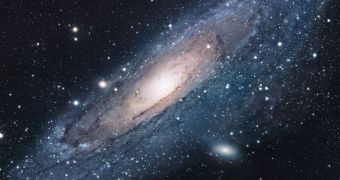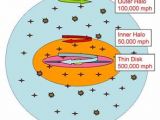As we all know by now, our solar system is located in one of the arms of a spiral galaxy, which we call the Milky Way, that is part of a collection of galaxies known as the local group. Original studies on the Milky Way and the galaxies in its vicinity showed that spiral galaxies consist of a massive core composed of thousands of stars packed around a supermassive black hole, surrounded by a thin disk of matter stretching hundreds of thousands of light years into space, in a structure presenting arms similar to the hurricane spiral bands.
Aside the thin disk of matter and the core, the galaxy is also surrounded by a halo consisting of old stars and several star clusters that lie at a distance of one hundred thousand light years away from the center of the galaxy and can stretch as much as two hundred thousand light years into space, thus the Milky Way is composed of two distinct components, the inner flat spiral disk and the outer halo.
Past measurements made on the orbits of the stars surrounding the central core and the composition of the stars situated in the outer regions of the galaxy revealed that these stars are rather old and might have formed in very different ways than the relatively young stars situated closer to the central core.
With the help of the measurements made by the Sloan Digital Sky Survey, which involved the study of more than 20,000 stars, scientists have been able to determine that the Milky Way galaxy has a spin that averages about 800,000 kilometers per hour. The outermost region of the halo, close to the galactic disk, is spinning in the same direction and has a speed of 80,000 kilometers per hour. However, the outermost region of the galactic halo, consisting of a small population of old stars, is spinning in the opposite direction of the galactic disk and the inner halo, with a speed of more than 160,000 kilometers per hour.
The chemical analysis of these scattered stars showed that they have a metalicity more than three times higher than that of most of the stars situated in the galactic disk, having a high content of iron, calcium and other heavy elements, which where created by extremely massive stars that spread their content to the new generation of stars at the end of their lives.
This evidence of galactic material spinning both ways suggests that the galaxy might have formed in a different way than previous models predicted. According to Timothy C. Beers of Michigan State University, the inner halo and the galactic disk formed first as they share similar characteristics, from collisions with smaller galaxies or star clusters captured by Milky Way's powerful gravitational field, and the outermost halo might have formed much later from remnants of galaxies torn apart by the gravitational field while passing by.

 14 DAY TRIAL //
14 DAY TRIAL // 
